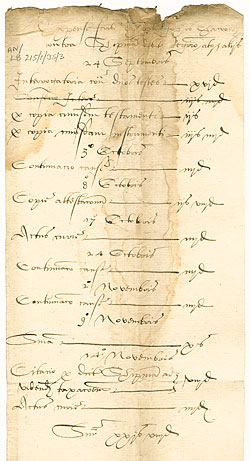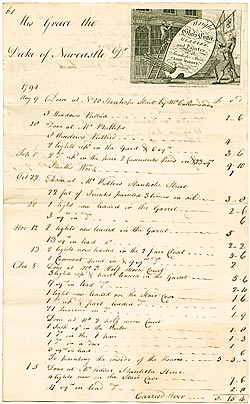Bills and Receipts
They say that 'money makes the world go round', but how does this happen?
At its simplest, everything (unless it's done for a purely altruistic reason) has to be paid for in some way. Workers receive salaries or wages. Utility companies send bills to their customers. Even someone helping an elderly relative with the gardening might expect a cup of tea and a biscuit at the end of the afternoon.
Similar transactions have gone on for hundreds of years. However, because records of them are handwritten, and employ unfamiliar words and phrases, we may not always recognise them as part of our common financial culture. Payments for goods and services can be made using one of three methods:
- in kind, that is by bartering other goods or services in exchange. This method of reward is not discussed in this Skills Unit, because records relating to it are rarely written down. However, it was an extremely important and widespread method of payment used by ordinary people during the medieval and early modern period
- in cash, that is by the immediate payment of money. Receipts are a record verifying that the money had been paid. Until 1971, money in the United Kingdom was in the form of pounds, shillings and pence. If you are unfamiliar with this system, please look at our Skills Unit on Weights and Measures
- on credit, that is by promising to pay money at a future date. Bills or invoices are sent out to customers after the goods have been delivered or the services completed. The company then becomes a 'creditor' to the customer, who pays the money he owes at a later date. Again, receipts provide proof of payment
The following two sections will explain bills, invoices, and receipts in greater detail.
Bills and Invoices
A bill is a demand for payment for services done or goods rendered. It might list every item in detail, or it might only give the total amount owed.
An invoice is a similar document. It itemises goods which have been ordered, gives the price of each item, and the total of the order. Invoices are sent out with the goods. The purchaser might respond immediately to the invoice by paying the amount due, or might wait until a further bill is sent out at a later date.

Archdeaconry bill of costs, c.1577 (AN/LB 215/1/35/3)
View larger version
Until around the sixteenth century it was usual for financial records to be written in Latin and to use Roman numerals. This example is the earliest bill in the archive of the Archdeaconry of Nottingham, which used Latin for bills until 1733. It is headed 'Expense facte ex parte Johanis Chaworth contra Shipman debit Registrario atque alijs'. It is a bill of costs charged to John Chaworth for expenses in a legal case brought against Shipman. The money is owed to the Registrar of the Archdeaconry court and to other people such as the church lawyers.
The bill itemises each of the costs, which are described in Latin and broken down by date. The costs include making a copy of a will (24 September), proceedings in court (17 October), and general costs of the continuation of the case (24 October and 2 November). The monetary amounts are given in Roman numerals. The total is given at the end: an abbreviation for 'Summa', and 'xxjs viijd' [21 shillings 8 pence].
The bill is undated, but can be estimated at around 1577 from other documents relating to the same legal business in the Archdeaconry archive.

Illustrated bill, post-1795 (NL 10/1)
View larger version
This later bill is the first page of a bill sent by Mr. Wright, glass cutter, glazier and painter, of 48 Stanhope Street, Clare Market, London, to the 3rd Duke of Newcastle, for work done at various houses in London from 9 August to 20 December 1794.
As printing became cheaper and more sophisticated, many tradesmen began to embellish their bill headings with fancy writing and pictures. This bill is illustrated with engravings of a man up a ladder painting a window frame, and of an artist painting a picture. This was an early form of advertising of the kind of work the firm undertook.
As in the earlier account, the money being charged is itemised in order of date, but the figures are given in ordinary Arabic numerals. The bill has not been endorsed or otherwise marked to acknowledge receipt of the money.
Receipts, Vouchers and Quittances
All of these are methods of proving that a payment has been made.
The term 'voucher' is most commonly found in estate accounts. A voucher is a note attesting that a particular payment was correct. On many landed estates, the agent collected paid bills and receipts together and wrote reference numbers on the back of each of them. The bills and receipts then became collectively known as 'vouchers'. They were sorted and the details abstracted into the official annual or six-monthly estate account. The account could be audited by referring back to the bills and receipts using their reference numbers.
A 'quittance' (often written as 'acquittance') is a note verifying the payment of a debt or obligation, for instance the payment of a marriage portion out of a landed estate. Quittances are also sometimes called 'releases', because the person is thereby released from their debt or obligation.
Many bills have receipts written onto them, stuck onto them, or pinned onto them. Other receipts are found loose. It is quite common to find that a receipt has survived, but the bill has not, or vice versa.
Bills and receipts paid by the Marquess of Titchfield, 1795 (Pl F1/3/7/7/46 and Pl F1/3/7/7/48)
View larger version: page 1, page 2
The first bill shown here lists items bought by the Marquess of Titchfield from W. & G. Bicknell, Town Manufacturers of Hosiery, Hats and Gloves, at the corner of Old Bond Street, London, between 5 January and 26 July 1793. The bill also includes a demand for the total amount of some earlier bills delivered at various times since October 1790.
The bill was presumably ignored, because the second document is another bill sent out from Bicknells. This bill simply demands payment for 'Bill[s] Deliver'd from Septm. 1790 to July 93'. The bill was finally paid on 21 February 1794, and returned with an attached receipt.
The second bill on its own gives very little information. However the earlier, itemised, bill gives a great deal of information about the kind of goods purchased by the Marquess of Titchfield.
Next page: Cash Substitutes